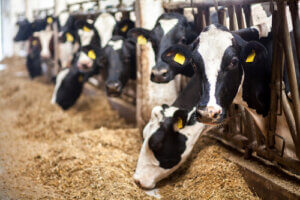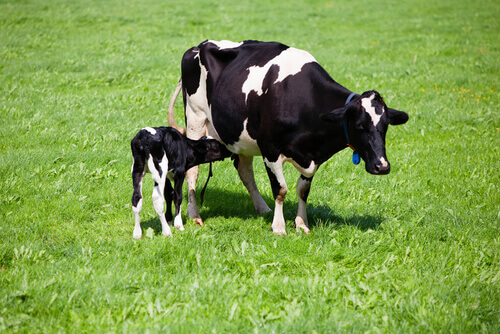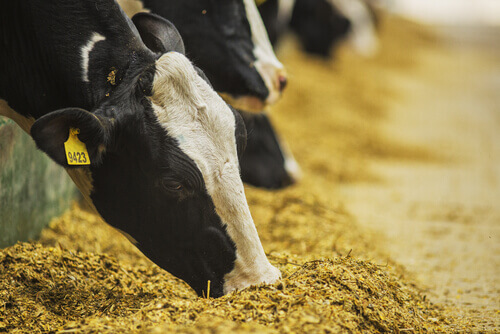Cow Reproduction and Milk Production

The life cycle of a cow is a little different from that of humans. This might make you wonder exactly what their life cycle entails. In this article, we’ll talk to you about cow reproduction and milk production.
If you didn’t know, humans are the only mammals in the world that drink milk past infancy. Another unknown fact is that cow reproduction is essential to ensure uninterrupted milk production.
Keeping the population in check
Intercourse between a cow and a bull rarely occurs in animal husbandry, as it can be dangerous for both animals. Cows are usually artificially inseminated by farmers to avoid any risks.
Remember that artificial insemination is the process by which a male’s sperm is inserted into a female’s uterus. This can be done in both humans and animals.
Gestation can’t occur at any time of the year. In fact, it can only occur when a cow is on heat. This process has a duration of approximately 18 hours, which is why a farmer has to inseminate a cow right away to be able to preserve their farm.

Depending on the breed, gestation can last about 278 days, with the exception of Jerseys and Holsteins. Experts recommend cows to continue this cycle every 12 or 13 months to facilitate milk production.
Cow reproduction and their diet
Once a calf is born, the cow is ready to feed it its milk. Even though calves are adequately fed from their mother, much of the milk remains inside the utters. Humans have learned to take advantage of this benefit.
It’s worth mentioning that a cow’s diet while nursing is very important, as the animal uses extra energy to produce milk. Thus, farmers must feed their cows a high quality feed instead of letting them only eat grass, as they’re used to.
Although grass is the ideal food for cows, it doesn’t provide them the necessary energy. As such, grass-fed cows could suffer from caloric deficiency, which affects their behavior and production rate.
Grass-fed cows could even lose a significant part of their body weight (approximately 10%) and won’t be able to reproduce normally. On the contrary, if the animal is given supplements and fed other substances with a higher caloric content, it’ll only lose 1.5% of its weight.

Experts recommend feeding dairy cows foods that elevate the amount of calories consumed, including those rich in starch. Foods such as cassava, rice, and oats are good options that you can mix with grass to facilitate consumption.
Aside from the weight-energy relationship, other factors such as the animal’s age, climate, and general health play a role in cow reproduction and milk production. A young dairy cow will produce more milk than an older one.
Conclusion on cow reproduction and milk production
Farmers have to monitor their animals’ estrous cycles to know the right moment for the cows to reproduce. This is the moment when they should inseminate the animal to ensure successful fertilization. The animal must complete this cycle every 12 to 13 months to stay healthy.
As a general rule, farmers should make sure the animal is healthy before starting the process, since a sick specimen can cause more problems than long-term benefits. Also, they must make sure that both mother and calf won’t have any problems in the future.
Diet is essential, as it influences fertility and the animal’s general health. A healthy cow can produce more milk in a particular period of time. In addition, feed quality is essential, as it helps keep cows in a healthy weight and improves milk production.
La reproducción de las vacas y la producción de leche – Mis Animales
The life cycle of a cow is a little different from that of humans. This might make you wonder exactly what their life cycle entails. In this article, we’ll talk to you about cow reproduction and milk production.
If you didn’t know, humans are the only mammals in the world that drink milk past infancy. Another unknown fact is that cow reproduction is essential to ensure uninterrupted milk production.
Keeping the population in check
Intercourse between a cow and a bull rarely occurs in animal husbandry, as it can be dangerous for both animals. Cows are usually artificially inseminated by farmers to avoid any risks.
Remember that artificial insemination is the process by which a male’s sperm is inserted into a female’s uterus. This can be done in both humans and animals.
Gestation can’t occur at any time of the year. In fact, it can only occur when a cow is on heat. This process has a duration of approximately 18 hours, which is why a farmer has to inseminate a cow right away to be able to preserve their farm.

Depending on the breed, gestation can last about 278 days, with the exception of Jerseys and Holsteins. Experts recommend cows to continue this cycle every 12 or 13 months to facilitate milk production.
Cow reproduction and their diet
Once a calf is born, the cow is ready to feed it its milk. Even though calves are adequately fed from their mother, much of the milk remains inside the utters. Humans have learned to take advantage of this benefit.
It’s worth mentioning that a cow’s diet while nursing is very important, as the animal uses extra energy to produce milk. Thus, farmers must feed their cows a high quality feed instead of letting them only eat grass, as they’re used to.
Although grass is the ideal food for cows, it doesn’t provide them the necessary energy. As such, grass-fed cows could suffer from caloric deficiency, which affects their behavior and production rate.
Grass-fed cows could even lose a significant part of their body weight (approximately 10%) and won’t be able to reproduce normally. On the contrary, if the animal is given supplements and fed other substances with a higher caloric content, it’ll only lose 1.5% of its weight.

Experts recommend feeding dairy cows foods that elevate the amount of calories consumed, including those rich in starch. Foods such as cassava, rice, and oats are good options that you can mix with grass to facilitate consumption.
Aside from the weight-energy relationship, other factors such as the animal’s age, climate, and general health play a role in cow reproduction and milk production. A young dairy cow will produce more milk than an older one.
Conclusion on cow reproduction and milk production
Farmers have to monitor their animals’ estrous cycles to know the right moment for the cows to reproduce. This is the moment when they should inseminate the animal to ensure successful fertilization. The animal must complete this cycle every 12 to 13 months to stay healthy.
As a general rule, farmers should make sure the animal is healthy before starting the process, since a sick specimen can cause more problems than long-term benefits. Also, they must make sure that both mother and calf won’t have any problems in the future.
Diet is essential, as it influences fertility and the animal’s general health. A healthy cow can produce more milk in a particular period of time. In addition, feed quality is essential, as it helps keep cows in a healthy weight and improves milk production.
La reproducción de las vacas y la producción de leche – Mis Animales
This text is provided for informational purposes only and does not replace consultation with a professional. If in doubt, consult your specialist.








